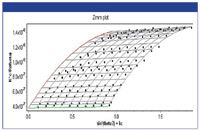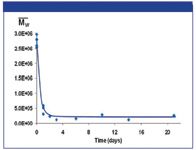Self Assembly for Lignin Biopolymersor Protein
In many solution studies of lignin the need to invoke association and aggregation phenomena has become apparent.
In many solution studies of lignin the need to invoke association and aggregation phenomena has become apparent. In our laboratory, we used the DAWN in a static mode, equipped with the appropriate cell configuration to systematically study such phenomena for lignin. The challenges and opportunities of measuring dn/dc of lignin solutions and determining the kinetics of the dissociation process were thus explored.
For these experiments, a new method for lignin isolation was developed aimed at producing lignin that was representative of the overall material in wood with the ability to display the propensity for aggregation (J. Agric. & Food Chem.; 54(16), 5939–5947, 2006). Furthermore, an additional method for fully solubilizing such biopolymers in THF was further developed. Carefully prepared lignin solutions (0.02 to 2.0 mg/mL) were then conditioned and their dn/dc values determined using the Optilab DSP interferometric refractometer operating at 633 nm. The temperature of the refractometer's cell was kept at 35 °C and an HPLC pump was used to deliver the sample via a 4 mL loop (Figure 1).

Figure 1: Optimal acquisition of the refractive index increment with the Optilab.
A very significant effort was spent to devise a procedure for obtaining smooth measurements in THF whose details will be elaborated later. For example, the THF to be used should previously be appropriately conditioned while the lignin solutions should be carefully prepared with the same equilibrated THF on the day of the analysis. The sample solutions should also be injected within the sample loop at a similar flow rate as the one used to deliver the material to the refractometer, thus avoiding pressure pulse memory effects that could be conveyed to the sensitive cell.

Figure 2: Typical zimm plot for lignin.
Observing these details allowed the determination of highly accurate Mw values for lignin solutions to be obtained as a function of time (see Figure 3). This effort when coupled to additional work using static measurements and Zimm plots for the same solutions as well as independent size exclusion runs, offers insight into the self-assembly processes operating within the lignin biopolymer (Figure 2). Such processes are of extreme significance as far as the biology of its deposition in the plant cell wall is concerned.

Figure 3: Understanding lignin self-assembly and dissociation.
This note was graciously submitted by Sofia Contreras, Armindo R. Gaspar, Anderson Guerra, Lucian Lucia, and Dimitris S. Argyropoulos*, Organic Chemistry of Wood Components Laboratory, Department of Forest Biomaterials Science & Engineering, North Carolina State University, Raleigh, NC.; Email:dsargyro@ncsu.edu

Wyatt Technology Corporation
6300 Hollister Avenue, Santa Barbara, CA 93117
tel. (805)681-9009; fax (805)681-0123
Website: www.wyatt.com

SEC-MALS of Antibody Therapeutics—A Robust Method for In-Depth Sample Characterization
June 1st 2022Monoclonal antibodies (mAbs) are effective therapeutics for cancers, auto-immune diseases, viral infections, and other diseases. Recent developments in antibody therapeutics aim to add more specific binding regions (bi- and multi-specificity) to increase their effectiveness and/or to downsize the molecule to the specific binding regions (for example, scFv or Fab fragment) to achieve better penetration of the tissue. As the molecule gets more complex, the possible high and low molecular weight (H/LMW) impurities become more complex, too. In order to accurately analyze the various species, more advanced detection than ultraviolet (UV) is required to characterize a mAb sample.















